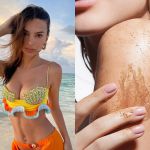
5 things to know to elevate your scrub routine
Are you sure to know everything about scrub?

March 22nd, 2022
Originally, it was the peoples of the Middle East who, with the hammam ritual, introduced into the beauty routine the concept of the scrub as a moment of purification, imbued with the religious meanings that the Arab world associated with the evocative places of well-being known today by the generic name of Turkish baths. But what is it specifically for? The scrub - which in English means "to rub" - helps to remove dead cells from the upper layer of the epidermis, operating a deeper cleaning than the normal cleansing with the bath foam. Through the massage, in fact, cellular turnover is activated and circulation is stimulated. The abrasive action also prevents the formation of horny plugs at the level of the glands, which would contribute to the formation of blackheads, mini cysts etc. After the scrub, the skin is immediately smoother and able to absorb the active ingredients contained in creams, especially anti-cellulite, slimming or firming. In summer, moreover, it makes the complexion and the tan more homogeneous, even if it is difficult to believe it because the immediate sensation is that the mechanical exfoliation "erases" the complexion. In reality, tanning is not a process that concerns only the superficial layer of the skin, but starts from the deeper layers: therefore, eliminating dead surface cells brings out the complexion. Finally, it renews the thickened epidermis, fights dryness and cracking.
But are you sure you know exactly everything about the scrub? Here are 5 things to know about the skin treatment that all of us, at least once in our lives, have done and wondered, "What is it for?"
The difference between scrubs, peelings or gommages
The first is a mechanical exfoliation, delicate and calibrated, which - thanks to the presence of natural abrasive microgranules (Jojoba microspheres, seeds, etc.) - makes the skin smoother, softer and brighter. It is particularly suitable for thickened, oily and impure skins. The Gommage is very similar to the scrub, but differs in its delicacy. It is the treatment indicated for the most sensitive skins, always made with granular products accompanied by moisturizing agents, such as oils or creams. Finally, peeling is a chemical type of exfoliation and has a deeper and faster action than the mechanical one, promoting cell turnover in a shorter time. It is an excellent treatment against dry skin, as it avoids mechanical stress, while stimulating collagen production and skin oxygenation.
In the shower
Massaging the skin in the shower with the scrub makes you feel less hot. The reason is due to the reactivation of the blood circulation that brings more oxygen to the cells. If, moreover, at the end of the day you apply it on your legs, the sense of tiredness is immediately reduced. Be careful only to apply it before the bath foam because, the latter, could alter the exfoliating properties of microgranules, that's why it is good to use it after.
Circular movements are the key
The scrub should preferably be applied on damp skin and should be massaged with small circular movements, from the bottom to the top and from the extremities of the body towards the heart: in this way the circulation is reactivated, giving a burst of energy to the venous return. Pressures should not be excessive, otherwise you risk irritation.
Consistency is key
The body scrub can be performed regularly from 2-3 times a month to 1-2 times a week. As for the face, the treatment can be repeated once every 10-12 days, if the skin is not particularly delicate. In the presence of ingrown hairs, the frequency can be increased and the use of cosmetic scrubs can be alternated with gloves made of natural fabrics, such as horsehair, sisal, loofah and bamboo.
Interested areas
On the face, a specific one, and on the body, but not on the bikini area or underarms.
Are you ready? Here are 10 face and body scrubs to try now:




































































